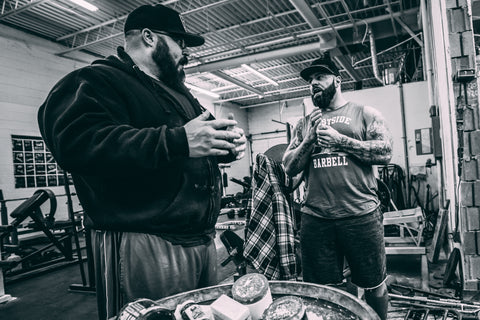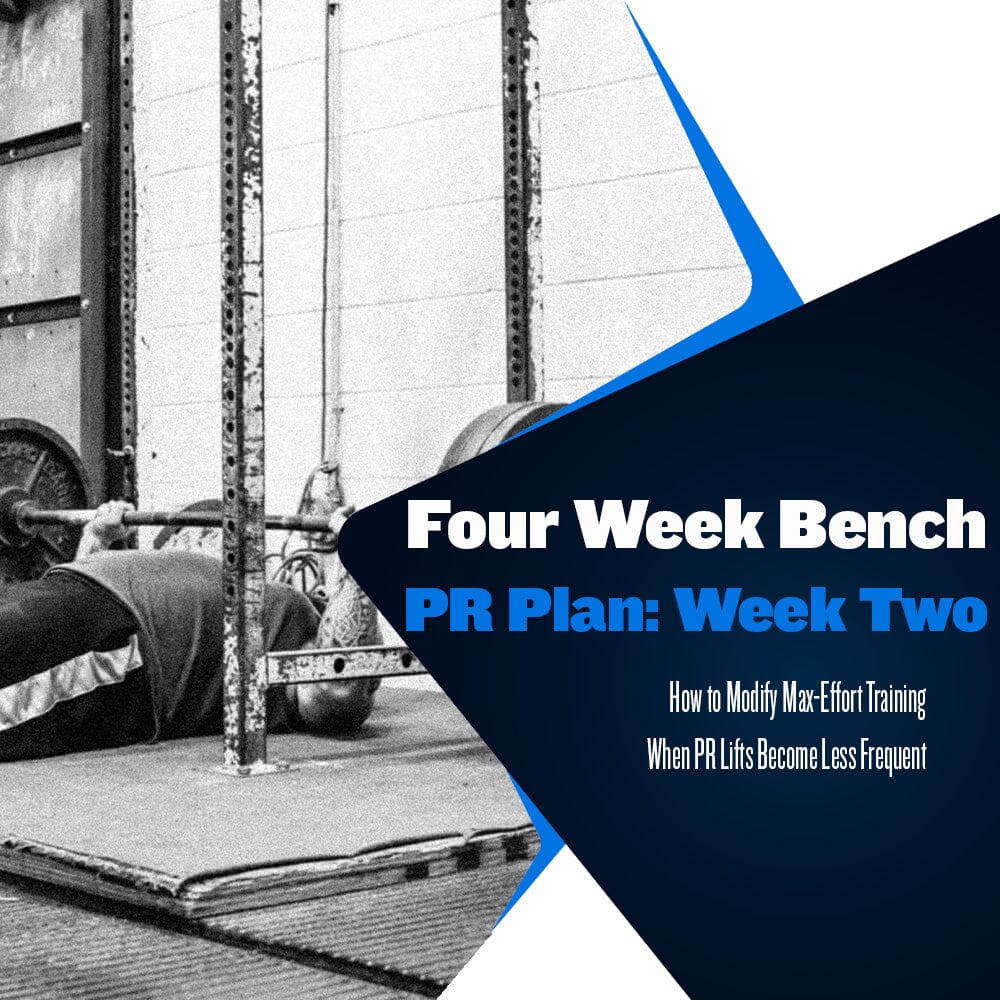Four Weeks to a Bench PR: Week Two

Week two of the four-week bench PR program is where we begin to work at a high intensity. Last week, we performed the close grip bench press for a top set of five reps. The intention of programming a top set of five reps last week was to give ourselves a break from 90%+ max-effort training while still providing enough training stimulus to improve absolute strength to some degree.
Ideally, an athlete should be rolling into the training week feeling adequately recovered and ready to handle some heavy weights. This week, we will work up to our first max-effort single attempt of the four-week PR training plan. This week will test an athlete's most significant weakness in the bench press.
Bench press weakness usually manifests itself in one of two ways; an athlete is weak off the chest or weak from the halfway point to lockout. Either way, these weaknesses significantly impact how much and how quickly your bench press strength will improve. Fortunately, there is a simple solution for this issue; a special exercise variation focused on training the specific joint angles an athlete finds weakest.
Main Exercise
The main exercise you perform for this training day will depend on where you struggle with the bench press most, off the chest or towards lockout. We recommend performing max-effort pin presses for athletes who struggle with strength off the chest or max-effort floor presses for athletes who struggle with lockout strength.
No matter which of the two exercises you choose, it is vital to understand how to set up and execute each exercise correctly. When performing the pin press, we will place the pins in a position that allows the lifter to get under the bar, with the pecs and anterior shoulder muscles shortened enough to prevent excess strain.
This depends on the bench form/grip and the athlete's build, so there is no one size fits all starting position. Be sensible with your starting position, and ensure you have the bar placed so that you are training the joint angles you struggle with most without putting any excess stress on the pecs and shoulders.
To execute a pin press, you want to get into an advantageous starting position. This is done by ensuring the upper back is set correctly, and the torso arch transfers the leg drive to the upper back, establishing a solid brace, and gripping the bar as tight as possible before pressing the barbell. Doing these few things will give you the stability and leverage you need to get the barbell moving without excessive pain or strain.
The floor press is easy to set up; the trick is proper execution. You will first lay on the ground to set the floor press up. Next, you will establish where you need to have the pins or J cups set so that you or a training partner can hand the barbell out without pulling the barbell away and causing your back to flatten. Once you figure out how you're going to lay under the bar and the height you're going to set the barbell, you're ready to begin pressing.
The floor press requires an athlete to be strict with their form. Without proper execution, the floor press is rendered less effective than it otherwise would be and will provide misleading training feedback. A proper floor press is performed by setting up under the barbell the same as you would if you were about to bench press. You want to wedge your upper back into the ground, establish a strong torso brace, and place your hands in a position that allows your triceps to exert maximal force into the barbell.
You can have your feet planted on the ground or your legs completely straightened like you're lying down. Planting your feet on the ground allows a lifter to establish a bit of an arch and get some leg drive into the press. Once the barbell is in motion, it is essential to know what we are looking for; we want a controlled eccentric where the athlete allows the triceps to lay completely flat on the ground.
This means the triceps muscle is lying completely parallel with the ground from the elbow to the posterior shoulder. Once this is achieved, the athlete will drive as much force as possible into the barbell to move the weight to lockout. When performed correctly, the floor press will rapidly increase the strength of the upper back and arms.
Here is how a 500lb bencher would perform each of these exercises:
Pin Press
Set 1 - 135lbs x 10
Set 2 - 225lbs x 5
Set 3 - 275lbs x 5
Set 4 - 325lbs x 5
Set 5 - 365lbs x 1
Set 6 - 405lbs x 1
Set 7 - 445lbs x 1
Set 8 - Max Attempt
Floor Press
Set 1 - 135lbs x 10
Set 2 - 225lbs x 5
Set 3 - 275lbs x 5
Set 4 - 325lbs x 5
Set 5 - 365lbs x 1
Set 6 - 405lbs x 1
Set 7 - 445lbs x 1
Set 8 - 475lbs x 1
Set 9 - Max Attempt
As you can see, we begin with a warmup and lead into working sets around sets 6-7. These jumps in weight are just examples, and preferred weight jumps set to set will differ depending on the athlete. No matter how you choose to go about it, go about it in a way that sets you up to lift the heaviest weight you can for that training day. Don't waste time performing excess amounts of warmup reps.
Accessory Exercises
As was mentioned last week, we are programming under the assumption the athlete is dealing with weak triceps. The previous training week also included a good amount of accessory exercise volume, most notably a primary accessory exercise - the push press. This week, given the increase in intensity during our main exercise, we will not include a primary accessory exercise, and we will reduce the overall accessory exercise volume slightly.
The goal is always stimulation, not annihilation, so we want to ensure we are trading off some volume for the increase in intensity to allow the recovery rate between training sessions to remain unchanged. If we were to pile on the same volume as last week with the added training intensity, we would inevitably add to the recovery needs of the athlete.
Here are the suggested accessory exercises for this week:
Exercise 1 - Barbell Rows - 5 x 5
Exercise 2 - Skullcrushers - 4 x 12-15
Exercise 3 - Seated DB OHP - 3 x 8-10
Exercise 4 - Tricep Rope Pressdowns - 3 x 15
Exercise 5 - DB Bicep Curls - 4 x 12-15
Exercise 6 - Standing Lateral Raises - 3 x 15
As you can see, we focus on developing all muscles involved in the bench press, with the triceps receiving some additional volume. When performing accessory exercises, we always want to complete each set using the heaviest weight we can use while performing all prescribed sets and reps with proper form. We often leave 1-2 reps in the tank when performing accessory exercises.
Attack Your Weakness
This week intends to force athletes to become comfortable where they are most uncomfortable. As we mentioned above, no matter the athlete, everyone has a weak part of their bench press. Like any other time, working through it is the only way to conquer your weakness. Sometimes the solution to improving a particular point or position of a barbell lift is to employ joint angle-specific training to become more comfortable where you feel most uncomfortable.
Although joint angle-specific training has received criticism in the past, most strength coaches realize the benefits of training your weakest points and choosing exercise variations that focus on those points and positions.
Should most of your main exercise selections use a limited range of motion focused on specific joint angles? No. However, dedicating one week per month to working within parts of a movement you're weakest or most uncomfortable in can be the secret to unlocking that next level of performance.
Identify the weakness, create an exercise variation, and attack the weakness. It is a simple yet effective strategy.
Read The Whole Series
Four Weeks to a Bench PR: Week One
Four Weeks to a Bench PR: Week Two (You are Here)
Four Weeks to a Bench PR: Week Three
Four Weeks to a Bench PR: Week Four
Where To Learn More
For even more guidance on bench pressing, including technique, effective training methods, and additional sample workouts, check out our Bench Press Manual here.
The Bench Press Manual by Louie Simmons is a comprehensive guide to mastering the bench press and achieving pers... The Bench Press Manual by Louie Simmons is a comprehensive guide to mastering the bench press and achieving pers...
$20
${ productPrice }
${ originalPriceWithQuantity }
${ productPrice }
$20
${ productPrice }
${ originalPriceWithQuantity }
${ productPrice }
Sources:
Simmons, L. (2007). Westside Barbell Book of Methods. Westside Barbell.
Verkhoshansky, Y., & Siff, M. C. (2009). Supertraining. Verkhoshansky.





